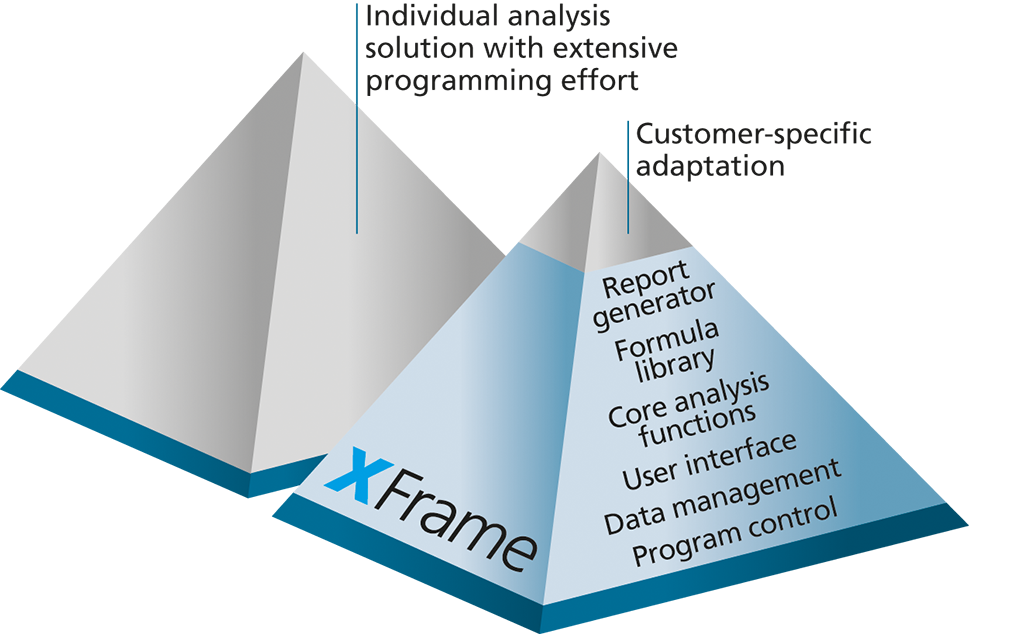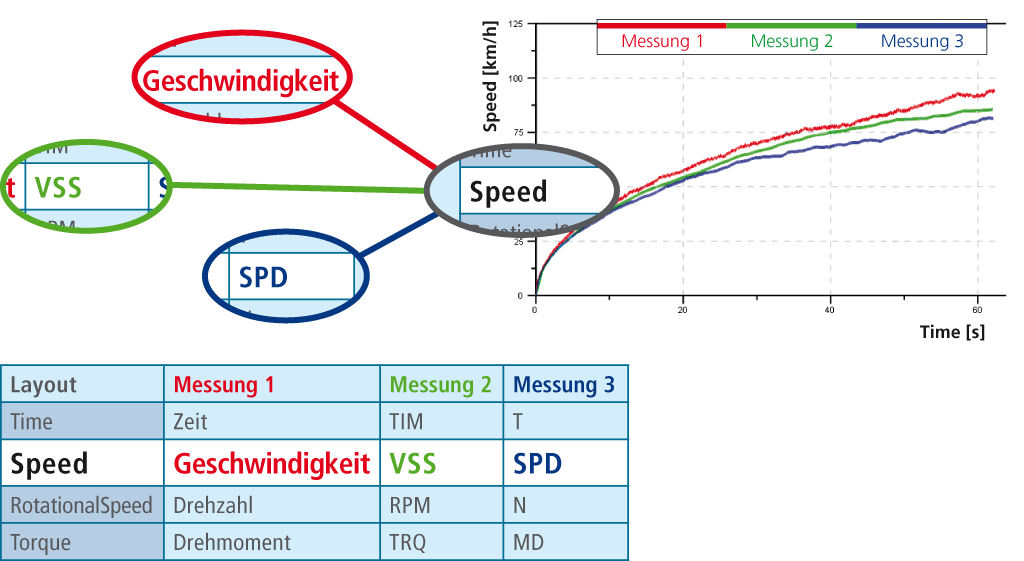Create your own evaluations faster with X-Frame
Test data management and analysis systems must be precisely adapted to the respective requirements. In order to still keep the amount of customer-specific programming as low as possible, we developed the universal analysis software X-Frame.
X-Frame brings with it all the fundamental functionality required. The evaluation algorithms, dialogs, user guidance and program control only need to be adapted to the specific project.

Your benefits:
- Efficiency: Applications can be developed more quickly.
- Convenience: The system is easy to use and parameterize.
- Flexibility: You will enjoy convenient customizing options.
- Extensibility: You profit from good scalability.
- Cost savings: The expenses for development, training and system maintenance are reduced.
- Future-proof: X-Frame has a large user base and is under continuous further development.
![]()
These are the highlights:
Structured evaluations and reports
X-Frame performs structured analysis of test data, whatever its origin, and visualizes it in clearly presented reports. You collect the data in a “shopping cart” and select an analysis task. X-Frame does the rest.
Broad spectrum of applications
Every customer project poses special requirements, and the X-Frame platform is excellently suited for implementing these. For this reason, we realize the majority of all analysis systems with X-Frame. This also helps make the software itself into an ever more powerful tool. For the benefit of all users.
Channel mapping enables universal evaluations
In X-Frame, special channel mapping functions ensure that even differently structured measurement data can be analyzed in a uniform manner.
During everyday analysis activities, it frequently occurs that different names are used for the same measurement value in comparable data records, meaning that these data sets cannot be analyzed uniformly without further effort. For example, test benches and measurement instruments of different manufacturers use different designations for the measured channels. Or the same channels are given different – or even nonspecific – names in different test procedures or different departments. Other designations can also differ, such as the units (e.g. mph instead of km/h). Or variables are missing that first have to be filled in by performing calculations based on other variables, such as calculating speed based on the distance traveled.
Channel mapping homogenizes measurement data
In X-Frame, the channel names occurring in the measurement data are automatically converted. The user can always use a generally applicable name. The evaluations, layouts and formulas created with this designation can in principle be used with all available measurement data.
Fore example, a channel would always be called “Speed”, although it is designated in the data records as “Velocity”, “VSS” or “SPD”. Even wildcards and regular expressions are possible in the assignment of source and target names. If necessary, the units of the measurement values can be replaced or converted, and undesired characters, such as spaces and special characters, can be removed or replaced. Completely missing measurement values can be calculated with the help of the formula catalog and inserted.

Either manual or automatic
Normally, the channel mapping is created manually, but it can also be generated automatically. In this case, an X-Frame evaluation is started in recording mode. The program shows the measurement values required for the evaluation to which the matching source names should be assigned. A special dialog supports the user with colored markings and a test function.
Various channel mapping configurations, such as for different measurement instruments or test bench types, can be defined and managed. The assignment of the correct mapping to a data record takes place either manually or via a script based on the measurement properties.
Channel mapping offers another advantages in addition to homogenization of the measurement data: It is possible to create universal evaluations that can be used for diverse measurement data – in combination with the appropriate mapping.
Next Highlight: Customizing
Parameterization instead of programming
For translation!!!! X-Frame offers extensive basic functions for data analysis and report generation. On this basis, you can carry out many different evaluations without the need to do any programming yourself.
Powerful formulas – predefined or custom
If an evaluation needs to make use of not only the measured values themselves but also derived values, the “X-Frame formulas” are available. With these formulas, it is possible to carry out both simple and complex calculations, determine proxy values and delineate sections. The formulas can be used like real measurement values in all parts of the program. X-Frame contains an extensive library of formulas that can be flexibly expanded.
Practical features
X-Frame contains many modular extensions. If necessary, all modules and functions can be expanded, modified or completely replaced.
Open to all data
The driver concept of X-Frame supports all typical data formats. A great many drivers can be installed directly. Driver interfaces are available for special or “exotic” file formats.
Extensive customizing options
Every analysis task poses special requirements. The basic configuration of X-Frame can be easily modified. By us or even by you.



